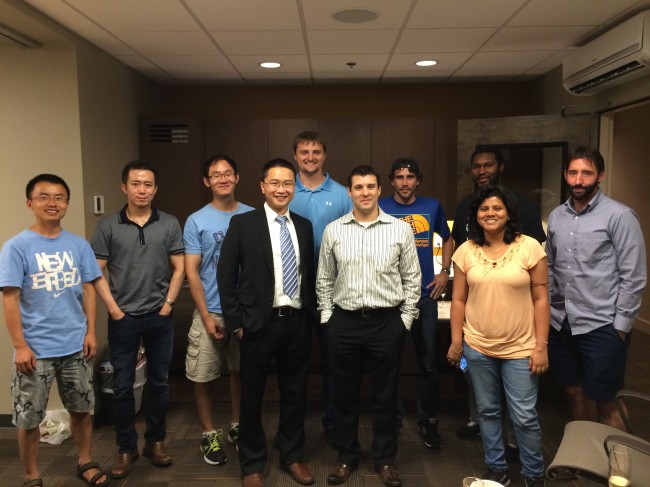Tong Hui successfully defended his Ph.D. dissertation. Congratulations Dr. Hui!
Tong Hui’s dissertation is entitled: Multiscale Modeling of the Dynamic Response of Composite Structures. He will continue his career at GE Global Research.
Dissertation Abstract
This research proposes a computational framework of the dynamic response of composite structures based on the mathematical homogenization theory with multiple spatial scales. The computational framework serves to reproduce wave dispersion and dissipation in composite structures. Firstly, the dynamic response of viscoelastic composite structures is investigated by simulating polyurea layered E-glass fiber-reinforced vinyl-ester (EVE) composites subjected to blast. The response of EVE layers is modeled based on a multiscale computational damage model that includes adiabatic heating and rate-dependence in the constituent (i.e., matrix and fiber) behavior. The numerical simulations are validated against experimental data demonstrating the capability of the multiscale model in capturing the inelastic response of EVE composite materials. The blast mitigation effect of polyurea layer is demonstrated numerically. The predictive simulations suggest better blast mitigation characteristics with thickening and boundary confinement of polyurea layers. Secondly, a high order homogenization model for wave propagation in elastic and viscoelastic composite structures is proposed. Asymptotic expansions with multiple spatial scales are employed to formulate the homogenization model. The proposed multiscale model operates in the Laplace domain allowing the representation of linear viscoelastic constitutive relationship using a proportionality law. The high order terms in the asymptotic expansion of response fields are included to reproduce micro-heterogeneity induced wave dispersion and formation of bandgaps. The first and second order influence functions and the macroscopic deformation are evaluated analytically for one-dimensional wave propagation and numerically for multi-dimensional wave propagation. The proposed model is used to reproduce wave propagations in elastic and viscoelastic composite structures. For elastic composites, the proposed model is able to capture complete density and modulus disparities induced wave dispersion and wave propagation within phononic bandgaps. The ability to model wave propagation within bandgap stems from the complex treatment of response fields. For viscoelastic composites, the performance of the proposed model is assessed by investigating wave propagation characteristics in layered and particulate composites. The analysis of dissipated energy reveals that material dispersion may contribute significantly to wave attenuation in dissipative composite materials. The wave dispersion characteristics are shown to be sensitive to microstructure morphology.
